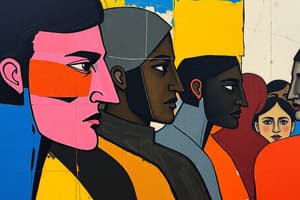Podcast
Questions and Answers
What is the primary characteristic of liminality in rites of passage?
What is the primary characteristic of liminality in rites of passage?
- It is when individuals fully transition into their new roles.
- It involves a formal, stylized practice.
- It marks the final stage of life.
- It is a marginal or in-between phase. (correct)
Which of the following is a defining feature of sacred rituals?
Which of the following is a defining feature of sacred rituals?
- They do not have a repetitive nature.
- They are grounded in a sacred belief system. (correct)
- They are spontaneous and unique to each individual.
- They are informal and lack structure.
Which of the following is an example of a rite of intensification?
Which of the following is an example of a rite of intensification?
- Birthday celebrations
- Funerals (correct)
- Graduation ceremonies
- Wedding rituals
What does syncretism refer to in cultural changes?
What does syncretism refer to in cultural changes?
What is a defining characteristic of sorcery or witchcraft?
What is a defining characteristic of sorcery or witchcraft?
Which factor is mentioned as an internal pressure for culture change?
Which factor is mentioned as an internal pressure for culture change?
What change did the Nyae Nyae Ju'/Hoansi experience in the 1980s-1990s?
What change did the Nyae Nyae Ju'/Hoansi experience in the 1980s-1990s?
What role does magic play in cultural practices?
What role does magic play in cultural practices?
What is the primary characteristic of transhumance?
What is the primary characteristic of transhumance?
What does the Sapir-Whorf hypothesis emphasize?
What does the Sapir-Whorf hypothesis emphasize?
Which of these statements about pastoralism is true?
Which of these statements about pastoralism is true?
How do the Ju/'hoansi people ensure future food supply through their social practices?
How do the Ju/'hoansi people ensure future food supply through their social practices?
What characterizes horticulture as a method of farming?
What characterizes horticulture as a method of farming?
What is a leveling mechanism in a society?
What is a leveling mechanism in a society?
What does participant observation involve?
What does participant observation involve?
What is the primary purpose of the hxaro exchange system in Ju/'hoansi culture?
What is the primary purpose of the hxaro exchange system in Ju/'hoansi culture?
What is conspicuous consumption primarily associated with?
What is conspicuous consumption primarily associated with?
Which term describes the process by which culture is transmitted from one generation to another?
Which term describes the process by which culture is transmitted from one generation to another?
What practice involves judging another culture by its own standards?
What practice involves judging another culture by its own standards?
Which type of agriculture is characterized by the use of irrigation and fertilizers?
Which type of agriculture is characterized by the use of irrigation and fertilizers?
What marked the transition of human societies from foraging to food production?
What marked the transition of human societies from foraging to food production?
What characteristic defines matrilocal societies?
What characteristic defines matrilocal societies?
What is a common feature of bilateral descent?
What is a common feature of bilateral descent?
Which of the following describes a chiefdom?
Which of the following describes a chiefdom?
What is the primary focus of sociolinguistics?
What is the primary focus of sociolinguistics?
What refers to a social class where membership is fixed by birth?
What refers to a social class where membership is fixed by birth?
What does the term 'race' refer to in anthropological context?
What does the term 'race' refer to in anthropological context?
What defines stratified societies?
What defines stratified societies?
Which of the following is an example of egalitarian societies?
Which of the following is an example of egalitarian societies?
What is double descent?
What is double descent?
Flashcards
Transhumance
Transhumance
The seasonal movement of livestock herds (often from lower to higher altitudes) to maintain or take advantage of optimum grazing conditions.
Proxemics
Proxemics
The study of personal space.
Horticulture
Horticulture
The cultivation of crops using simple hand tools such as digging sticks and relying solely on rainfall is a type of farming.
Creole
Creole
Signup and view all the flashcards
Culture-Bound Theories
Culture-Bound Theories
Signup and view all the flashcards
Pastoralism
Pastoralism
Signup and view all the flashcards
Carrying capacity
Carrying capacity
Signup and view all the flashcards
Leveling mechanism
Leveling mechanism
Signup and view all the flashcards
Rites of Passage
Rites of Passage
Signup and view all the flashcards
Liminality
Liminality
Signup and view all the flashcards
Magic
Magic
Signup and view all the flashcards
Sorcery/Witchcraft
Sorcery/Witchcraft
Signup and view all the flashcards
Syncretism
Syncretism
Signup and view all the flashcards
External Sources of Culture Change
External Sources of Culture Change
Signup and view all the flashcards
Diffusion
Diffusion
Signup and view all the flashcards
Internal Pressures on Culture Change
Internal Pressures on Culture Change
Signup and view all the flashcards
Globalization
Globalization
Signup and view all the flashcards
Cultural Relativism
Cultural Relativism
Signup and view all the flashcards
The Neolithic Revolution
The Neolithic Revolution
Signup and view all the flashcards
Conspicuous Consumption
Conspicuous Consumption
Signup and view all the flashcards
Culture Shock
Culture Shock
Signup and view all the flashcards
Enculturation
Enculturation
Signup and view all the flashcards
Sociolinguistics
Sociolinguistics
Signup and view all the flashcards
Intensive Agriculture
Intensive Agriculture
Signup and view all the flashcards
Ethnocentrism
Ethnocentrism
Signup and view all the flashcards
Holistic
Holistic
Signup and view all the flashcards
Chiefdoms
Chiefdoms
Signup and view all the flashcards
Polygyny
Polygyny
Signup and view all the flashcards
Polyandry
Polyandry
Signup and view all the flashcards
Nuclear Family
Nuclear Family
Signup and view all the flashcards
Swidden Agriculture
Swidden Agriculture
Signup and view all the flashcards
Study Notes
Culture-Bound Theories
- Theories incorporating comparative research across cultures to explain behaviours.
Creole Languages
- Languages combining elements of two or more languages, becoming a population's mother tongue.
Transhumance
- Seasonal movement of livestock herds, often between altitudes, to optimize grazing.
Pastoralism and Swidden Agriculture
- Subsistence strategies requiring extensive land use for sustainability.
Pastoralism
- Subsistence relying primarily on domesticated herd animals and products.
Food Foraging Societies (Ju/'hoansi)
- Employ codes of reciprocity and social norms of generosity to ensure food security.
Ferreira's Research (Xingu Park, Brazil)
- Xingu people utilize different mathematical calculations compared to non-indigenous groups, influenced by reciprocal obligations.
Horticulture
- Cultivation of crops using simple hand tools and rainfall.
Proxemics
- Study of personal space.
Sapir-Whorf Hypothesis
- Language influences thought, perception, and behaviour.
Ju/'hoansi hxaro Exchange System
- Circulates goods, lubricates social relationships, and fosters goodwill across camps.
Participant Observation
- Long-term immersion in a culture observing daily activities and interactions with detailed recording.
Carrying Capacity
- Maximum population size an environment can sustain.
Mobility
- All types of movement between locations.
Leveling Mechanisms
- Societal obligations for redistributing goods to prevent wealth accumulation by individuals.
Conspicuous Consumption
- Displaying wealth for social prestige.
Holistic Perspective
- Considering something as a whole, not just its parts.
Enculturation
- Process of transmitting culture from one generation to the next.
Cultural Relativism
- Judging cultures by their own standards.
Globalization
- Opening up world markets with modern technology.
Swidden Agriculture
- Involves burning vegetation to enrich soil but is often environmentally damaging.
Sociolinguistics
- Study of language's relation to its social context.
Culture Shock
- Difficulty experienced adjusting to a new, different culture.
Intensive Agriculture
- Using irrigation, fertilizers, and plows for sustained large-scale food production.
Neolithic Revolution
- Shift from food foraging to food production between 9,000 and 11,000 years ago.
Ethnocentrism
- Judging other cultures based on one's own culture.
Polyandry
- One woman, multiple husbands.
Matrilocal Societies
- Women dominate subsistence activities, often working in fields.
Nuclear Family
- Couple and their children.
Kindred
- Group of relatives (both maternal and paternal) affiliated through a living individual.
Chiefdoms
- Societies led by rulers relying on generosity, charisma, and leadership.
Polygyny
- One man, multiple wives.
Clan
- Descent group claiming common ancestor but not tracing specific links.
Sororal Polygyny
- Co-wives are sisters.
Adjudication
- Conflict resolution using an impartial third party for decision-making.
Bilateral Descent
- Affiliates individuals through both parents (both sexes).
Patrilocal Societies
- Societies emphasizing male cooperation (animal husbandry often involved).
Groom Service
- Groom works for bride's family for a set period.
Ju/'hoansi wi Name System
- Authority of older people over younger ones.
Band/Tribe Political Organisation
- Hunter-gatherers generally have bands; horticulturalists/pastoralists, tribes.
Serial Monogamy
- Series of successive marital partners but not simultaneously.
Double Descent
- Inheritance of rights through both matrilineal and patrilineal groups.
Big Man
- Charismatic leader organizing gift-giving feasts.
Avunculocal Societies
- Married couples live with groom's mother's brother.
Moka
- Pig gift exchanges among men, used for social standing.
Ju n!un Relationship
- Special relationship between in-laws.
Age Grade/Set
- Age groupings with shared rights and obligations (e.g., Kenya village example, children constructing huts).
Common-Interest Voluntary Associations
- Groups based on shared activities for rapid social change.
Measures of Social Stratification
- Skills, birth, wealth, and power differentiate societal standings.
Egalitarian Societies
- Societies with equal rank and resource distribution.
Stratified Societies
- Societies with hierarchy and privileged access to wealth, power, prestige.
Rank-Ordered Societies
- Recognized social standing based on graded ranks.
Class
- Groups with nearly equal prestige, power, and resources.
Closed Class Societies
- Social classes determined by birth, fixed for life.
Open Class Societies
- Social mobility between ranks possible.
Manifestations of Class
- Symbolic indicators, associations, health disparities, and longevity.
Race
- Group of people distinguished by physical traits (phenotype) and genetic origins.
Race Issues
- Not all phenotypic differences are genetic; boundaries are complex.
Cross-Cultural Variations in Race
- Varying understandings of race (e.g., US vs Canada).
Ethnicity
- Identity based on shared cultural traits (beliefs, habits, customs, religion).
Increasing Gender Stratification
- Lowered female status, increased male dominance.
Secular Rituals
- Scripted practices (e.g., athletes and rituals) for specific occasions.
Sacred Rituals
- Formal, stylized practices rooted in sacred belief systems to organize lives.
Rites of Passage
- Rituals marking life transitions (separation, transition, incorporation).
Liminality
- In-between phase of a rite of passage.
Rites of Intensification
- Rituals for group crisis/potential crisis, like funerals.
Rites of Purification
- Rituals to restore individuals' place in cosmic order after taboos are broken.
Individual and Group Rites
- Group/external practitioner draws on power and symbolism from earth, sky, etc.
Magic
- Use of supernatural forces for specific aims (e.g., improving outcomes).
Sorcery/Witchcraft
- Belief that some have supernatural power to harm/benefit others (often perceived as malicious or against one's will).
Culture Change: Internal Pressures
- Intergroup conflict (political, religious factions).
Culture Change: External Sources
- Trade, warfare, colonialism, globalization.
Culture Change: Process of Innovation and Invention
- Factors influencing acceptance (compatibility with existing systems).
Culture Change: Process of Diffusion
- Two-way process based on contact (direct or indirect) impacting local knowledge/practice.
Syncretism
- Blending elements from different cultures.
Missionism
- Spreading beliefs and values.
State Policies (Examples)
- Shrinking territories, conservation, border fences, land policies.
Change in Ju/'hoansi Subsistence Strategies
- Tensions from introducing farming/herding; wage work and migration impacting traditional practices.
Nyae Nyae Ju/'hoansi (1970s-1990s)
- Subsistence reduction, impacting social-economic factors and environmental impact; return to bush farming/coping with development efforts.
Studying That Suits You
Use AI to generate personalized quizzes and flashcards to suit your learning preferences.




